1966 Lotus Elan S3 SE FHC Jim Clark’s last road car
This Lotus Elan S3 FHC was Jim Clark’s last road car. We take to the border roads that formed him to find out why he found it so beguiling.
Taking a tour of multiple F1 Champion Clark’s life in his Elan S3, with his cousin on board
Fit For A Champion Touring the Scottish Borders in Jim Clark’s Lotus Elan S3 Coupé
Words ROSS ALKUREISHI
Photography JONATHAN JACOB
CHAMPION LOTUS ELAN
It’s the 60th anniversary of the Lotus Elan. Find me a famous car and road test it, please’ came the directive from editor Phil Bell. The period A-list owner roster provides an exhaustive choice, but for a Scotsman with even a hint of petroleum in his veins, to quote the Hollywood film Highlander, ‘There can only be one’. That’s why I find myself parking up in the centre of the Scots border town of Duns in front of the Jim Clark Motorsport Museum. A glass extension houses a roped-off-three-car display containing Jim’s 1964 BTCC-winning Lotus Cortina, his final road car – an Elan S3 – and a Lotus Type 25 R6 in which he took multiple F1 wins. My motoring lottery numbers have come up, because this is no static display – I’ll take the middle one, please. The Elan rekindled Jim’s love of driving; today I’ll find out how. As I fire up the twin-cam engine I’m joined in the cabin by my chaperone Doug Niven, The Jim Clark Trust’s family trustee –he’s also Jim’s cousin, and no mean racer himself. I experience a momentary frisson as I imagine Jim sitting here, one hand on the steering wheel and the other on the gear lever, before I shake it off, select first gear, and edge out into the morning traffic.
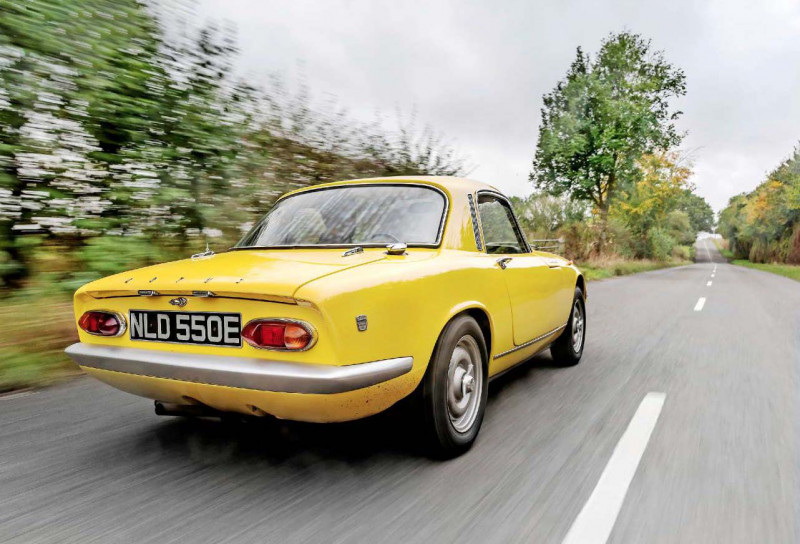
Trundling along, I’m reminded just how easy an Elan is to pilot – even a left-hand-drive example like this one. The steering is finger-light and direct and the softly sprung suspension soaks up road imperfections; Lotus learned from the Elite, which could be harsh and jarring on less than perfect surfaces, employing a separate backbone chassis for its new sports car.
The museum provides a map marked with a suggested 50-mile route that takes in important Jim Clark landmarks, but I’ve requested we do it in reverse, so we head south on the A6105. As we work our way towards the town’s outer edge it’s clear that both car and passenger are well-known in these parts – we’re receiving knowing nods and waves aplenty. Doug’s keeping his counsel though, allowing me to feel my way and get comfortable with Jim’s car. I’ve driven high-value cars on public roads, but this Elan’s historical importance ups the ante.
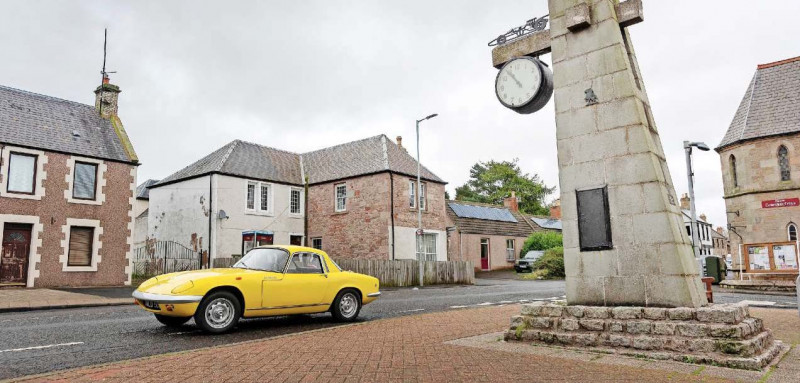
Clearing the town, I downshift, nail the throttle and that’s instantly forgotten. The intake noise is subdued – an air box stifles any outrageous Weber blare – although you’re always aware it’s there, as is the perky exhaust note. The punch on offer is significant; this was a fast car when new, and it remains so. However, that’s thanks to more than just light weight and twincam grunt, which is obvious through a long sweeping corner, the Elan’s chassis alive in an instant. Its poise is delicate, almost feline-like; it breeds confidence to go quicker through the next.
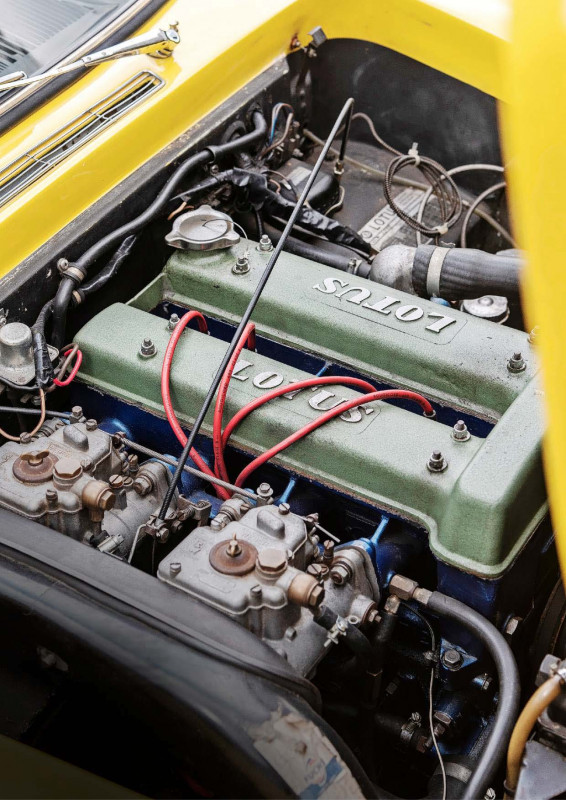
As we flash past Charterhall Airfield, the scene of Jim’s first official race, Doug takes up the story, ‘When Jim first came to the Berwick & District Motor Club he stood out and won his first event. But he hadn’t actually joined so couldn’t claim the prize. That put his nose out of joint; it took him a while to get over it.’ We soon reach another airfield, Winfield, and park up. Now a storage area for the local farm, it’s hard to imagine up to 50,000 people here watching the non-championship 1951 Scottish Grand Prix. By Jim’s time, its star had fallen somewhat but circuits like this would put on club-level driving tests and there were hill climbs up the Lammermuir Hills and other local sprints and events, in which Jim, still only 20 years old and piloting his father’s Sunbeam MkIII, quickly made a name for himself. Doug explains, ‘He was naturally a shy, nervous man and famously indecisive, but in a car though! He quickly became a little stalwart of the Club and on 16t June 1956 he went up to Crimmond in Aberdeenshire to be a mechanic for fellow motor sport-keen farmer Ian Scott Watson, who raced a DKW Sonderklasse. After a few events Ian asked, “Do you no fancy a wee go?” Jim had been told by his parents on no account to ever think about driving a car for a living, it was too dangerous – he was a farmer. Trouble was, at Crimmond he’d gone out there about three seconds a lap quicker than Ian. In the next race he raced as A.N. Other, but he didn’t know that a lot of his relatives who lived in Fife were there and word got back to his father.’ However, Jim’s elegant and seemingly effortless driving style had already set him on an unstoppable trajectory. ‘Ian entered him in the 1958 Boxing Day Brands Hatch race, driving his Elite. In those days Colin Chapman was driving. Jim was leading him and no-one had ever been ahead of him; ultimately, a backmarker held up Jim and Colin got past. After the race Colin said, “I’ve never heard of you, where have you come from?”
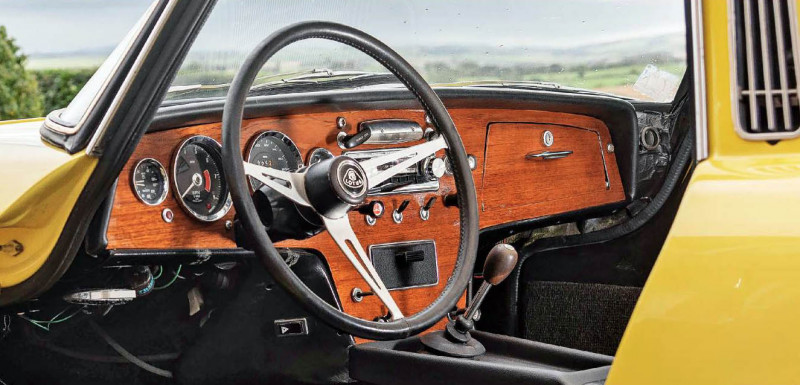
‘He later brought him down for a wee test. Graham Hill was there, and few other Formula 1 drivers. The instruction was to do a few laps. Jim matched the same times as everyone else; Chapman was incredulous. When Ian Scott Watson stated his own amazement – his friend had never before been in a single-seater – Chapman gave the instruction, “Get him in before he kills himself”. That was the start of his career.’
And what a career. Highlights included third overall at Le Mans in 1960 in the Border Reivers Aston DBR1 – ‘astonishing for a wee garage from Chirnside’ says Doug. He was 1963 and 1965 F1 World Champion, 1964 BTCC winner, and 1965 Indy 500 winner; he was the first non-American to win the latter since 1920. ‘I still remember going with his parents up to a cinema in Edinburgh at 2am to watch it on a grainy screen.’
We climb back in and head to Berwick-upon-Tweed, home of his Motor Club. Then Doug asks, ‘Would you like to visit Jim’s home?’ It hadn’t been on the agenda, but one quick phone call and it is now. We head off-piste and hit a series of bends just north of Whitsome, where I enjoy clipping an apex or two and powering through. The Elan reminds me of a featherweight boxing champion – happy jabbing at a distance, but even more adept up tight. It’d leave an E-type punch-drunk here.
We’re greeted at Edington Mains Farm by proprietor David Runciman and quickly begin to manoeuvre the Elan into place, to recreate a famous shot: Jim, by then F1 World Champion, sitting on the bonnet of his Lotus Elan in full highland get-up. The advert ran the by-line, ‘I drive my Lotus Elan for pleasure – not because I have to.’ The Elan was not this one but 997 NUR, Carmen Red and the first pre-production car, and the first of the three Elans that he owned – the other being a Cirrus White S1 Radford conversion, CRO 291B, that hasn’t survived. NLD 550E never saw these roads, because Jim used it principally to drive to race circuits on the continent after becoming a tax exile.
After saying our goodbyes I ask Doug if he’ll take the reins as we retrace our steps south and rejoin the Trail. I want some time to take in the cabin and reflect on this car. He may be retired from both farming and racing, but there’s a glimpse of the family prowess. ‘People often wondered where Jim got his genes, because his father drove everywhere at 25mph! I can remember I went to a farmer’s meeting one night and it was snowing; a car came shooting past and someone said, “That’s Jim Clark getting back.” By then he was flying over to Winfield in his own plane.’
We cross over the River Tweed and follow its southern edge, flanked by the picturesque Lammermuir hills to the north and rolling Cheviots to the south. As Doug charges on, I pull out a photocopy of the Lotus Cars invoice. Unlike 997 NUR, which remained the property of Lotus, NLD 550E was registered to James Clark, by now of Pembroke, Bermuda; in reality he spent most of his time in Paris with his good friend, journalist Gerard “Jabby” Crombac. Ordered in left-hand-drive, the Type-36 Fixed- Head Coupé – new for the Series 3 – had the Special Equipment Modification that included high-lift camshafts, re-jetted Weber carburettors, servo-assisted brakes and knock-off wheels, as well as a 3.55:1 rear axle. Marketed as a ‘Luxury Coupé’, it boasted electric windows, more comfy seats and deep-pile Nylon carpets.
As we speed back to Chirnside, I’m reminded just how fast and fun the roads of this region are, with subtle undulations, long sweepers aplenty, and plenty of tight, twisty work too. And all with a distinct absence of road traffic – the perfect training ground for an aspiring racer. I’m bedazzled by the unruffled ease with which the Elan dispatches the terrain; you quickly lose yourself to its rhythm. The 3.55:1 rear axle lengthened its legs, turning what was an epic sports car into a joyous GT capable of long-distance touring, while the slightly lower first and second gear ratios ensured minimal impact on low-end acceleration. Jim stated to Jabby Crombac that, ‘On the continent I have re-discovered the joy of driving.’ It’s easy to picture Jim sitting behind this car’s steering wheel travelling to Europe’s great racetracks on deserted rural roads not unlike these, while visualising his upcoming work as he allowed the Elan to work its effortless magic. And he’d have still felt fresh on arrival too. Inevitably, at Chirnside, his fatal accident at Hockenheim circuit on 7 April 1968 finally intrude. I had deliberately asked that we reverse the Trail because I wanted to understand the people, places, roads and cars that shaped the man first.
We pay our respects in the church graveyard and then walk over to the memorial clock. Part of its inscription reads, “Farmer Edington Mains Chirnside World Champion Motor Racing Driver 1963 and 1965”. ‘He always saw himself as a farmer first and foremost,’ says Doug. ‘That season he came home just before the British Grand Prix and said to the men on the farm, “If you get the hay made before the weekend come down to Silverstone and we’ll look after you down there.” On the Saturday, after qualifying on pole, he saw his workers and asked, “Did you get the hay made?” Then he took them for some laps in his Cortina.’ Being allowed to enjoy Jim’s car on these roads today has been both emotional and a privilege. Yes, there’s a touch of melancholy – you’re left wondering what else he would have gone on to achieve both in racing and in life – but more than that, it’s been both revelatory and celebratory.
When Jim died, Doug took up racing and that included driving for the Border Reivers. ‘Both Jim’s and my own parents were against it, but what could you do? I got the racing bug too.’ He also continued his legacy off-track when he accepted Jim’s parents’ request to be a family trustee for The Jim Clark Trust. The Elan story too, didn’t end there. A +2 launched in 1967, followed by the ultimate incarnation, the ‘big-valve’ 126bhp Sprint in S4 form in 1970. And yet the two, legendary driver and legendary sports car, remain indelibly linked.
In Jim Clark, there’s no doubt that Colin Chapman found the ultimate proponent for the Lotus way, and the perfect ambassador for his road car. And in the Lotus Elan, well this Elan anyway, he rediscovered pure unadulterated driving joy.
Rest in peace, Jim.
Thanks to: The Jim Clark Trust and the Runciman family.
The museum is in Duns, but Jim is a son of Chirnside, where he lived, farmed and is buried. Jim specified inertia-reel seatbelts, a cigarette lighter, a radio and a cassette tape recorder for the cabin. Doug advises Ross on getting the best from the Clark Trail.
Jim grew up driving on Borders roads; today, they remain manna from heaven for those of a serious driving bent Wireframe Lotus 49 sits atop the Jim Clark memorial clock, which has stood in the centre of Chirnside since 1969.
TECHNICAL DATA FILE 1966 Lotus Elan S3 SE
- Engine 1558cc, in-line four-cylinder, dohc, dual Weber 40 DCOE 18 carburettors
- Max Power 115bhp @ 6250rpm
- Max torque 106lb ft @ 5000rpm
- Transmission Four-speed manual, rear-wheel drive
- Steering Rack and pinion
- Suspension Front: independent, double wishbones, coil springs and telescopic dampers. Rear: independent, lower wishbones, Chapman struts
- Brakes Discs front and rear, servo-assisted
- Weight 701kg (1545lb)
- Performance 0-60mph: 8.0sec.
- Top speed: 120mph;
- Fuel consumption 26mpg
- Cost new £1597
- Value now £250,000 approx
Re-jetted Weber 40DCOE carburettors were part of the Special Equipment Modification option.
Fixed Head Coupé brought weatherproof motoring to the Elan party; a long-wheelbase +2 joined it in ’67 It’s safe to assume that the Elan’s 6500rpm redline saw plenty of action at Jim’s hands Owner Peter Windsor reunited this S3 with its original UK registration post-restoration.
Outside Edington Mains Farm, the site of the famous photo – and apparently many parties… Jim specified left-hand-drive for the Coupé; he’d mainly be driving it in continental Europe. Ex-Jim Clark display illustrates his breadth of driving disciplines Sales invoice shows the Special Equipment Modification at £129 Scotsman Ross fulfils the drive of his childhood dreams
OWNING JIM CLARK’S LOTUS ELAN S3
F1 broadcaster and ex-Williams/Ferrari manager Peter Windsor has owned Jim’s S3 Elan since 2004. ‘My friend “Jabby” Crombac knew how much I loved the car and rang me to give me the heads up before he sold it through a small French auction house. Jabby himself had dropped Jim off at a small airport on the outskirts of Paris in April 1968, prior to Jim flying to Hockenheim. As he climbed out of the Elan, Jim said to Jabby, “The car’s yours. Keep it. I’m getting a new Plus 2, so you can have this.”
‘Jabby put a lot of miles on the car, going through at least one chassis and having it re-sprayed three times. I’ve tried to return it to how it was when Jimmy owned it. Andy Coxhead in Surrey perfectly repainted the body in the correct 1967 version of Lotus Yellow, with Henry Mann restoring the engine and gearbox. We also reinstated the original UK registration that Jim used throughout 1967. The car now splits its time between display in the museum and events raising money for charity. ‘I love the fact that, even though Jimmy was a high-flying double F1 World Champion and Indy winner, he remained so into this car; his pleasures remained simple ones.’


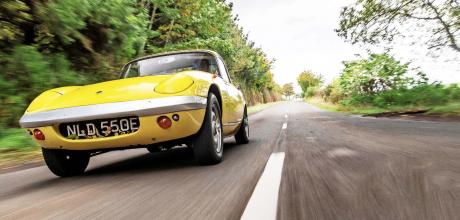
Then and now, the Lotus Elan could appear to be not a lot of car for the money. Well, until you drive one...
Motoring enthusiasts unable to get to Earls Court in October 1962 for the London Motor Show merely had to pop along to their local cinema to catch the highlights brought to them by Pathé News. A bit more effort required than reaching for your smartphone these days, but surely a more enriching experience. Following a brief sequence on the previous year’s Jaguar E-type, we cut to a lipstick red Lotus Elan, loaded with three cheerful-looking young ladies and rotating on a turntable.
In between innuendo-laden quips, our commentator finds space to talk about the car, ‘Much smaller, but very much in the high-performance class, the Lotus Elan is built on the foundation of racing success and with refinements every owner will appreciate.’ When the cameraman manages to tear his lens away from the young ladies, Sixties motoring enthusiast gets to marvel at what lies beneath those cheeky glassfibre curves. Painted, plated and polished to a level that foretold Seventies customisation trends, the Elan’s simple backbone chassis, independent suspension and twin-overhead camshaft engine certainly promised to live up to the hyperbole of being a product of motor sport-tuned minds.
Strangely for such a racing-focused manufacturer, its Elan wasn’t intended for competition use and it was the customers who provided the initial push onto track. When I say push, that wasn’t meant to be a cheap jibe on the Elan’s swiftly-earned reputation for not always functioning as intended. What racers professional and amateur, and wannabe racers on the road soon discovered, was a machine that reinvented what could be expected from a small sports car, not just in dynamic agility, but how it juggled the conflicting needs of the hotshoe driver with those of the owner who didn’t feel that a tiresome lack of comfort should be an essential price to pay. The hefty £1500 purchase price was steep enough.
All that was 60 years ago and we’re still going on about it. Time for an anniversary special package of features then.
Loved the articles on Jim Clark, and his Elan but According to the superb David Tremayne book (Jim Clark, the best of the best) the wireframe car on the Chirnside monument is a 33 and not a Lotus 49; the small no 1 confirms that. Clark won races in a 49 but never a World Championship.